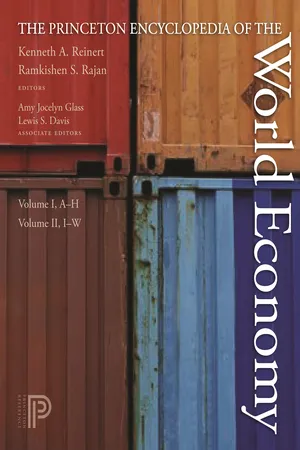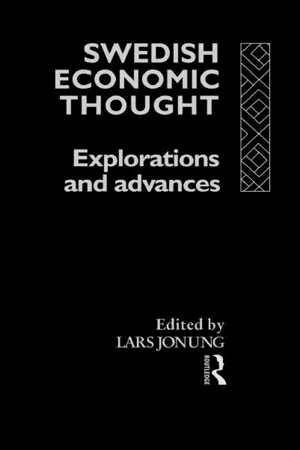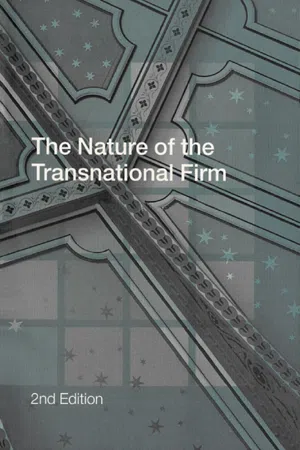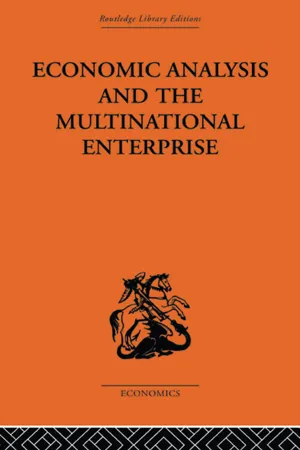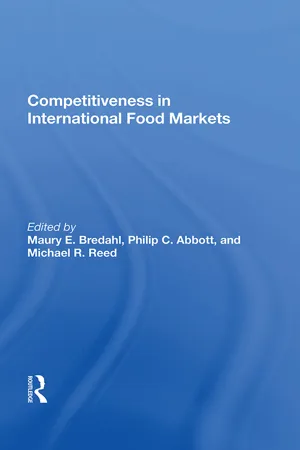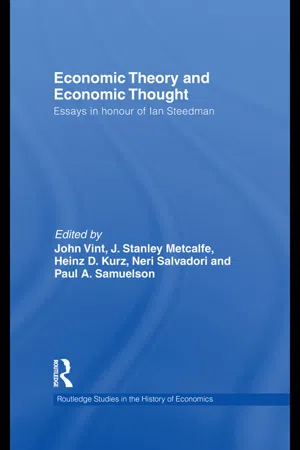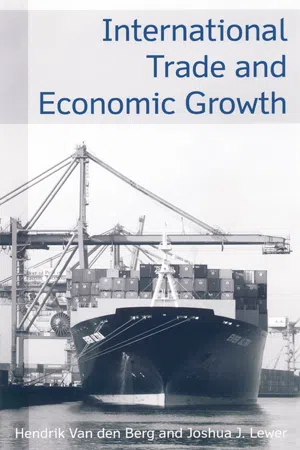Economics
Heckscher-Ohlin Model
The Heckscher-Ohlin model is an economic theory that explains international trade patterns based on the relative factor endowments of countries. It posits that countries will export goods that intensively use their abundant factors of production and import goods that intensively use their scarce factors. This model emphasizes the role of factor endowments, such as labor and capital, in shaping trade patterns.
Written by Perlego with AI-assistance
Related key terms
Related key terms
1 of 4
Related key terms
1 of 3
12 Key excerpts on "Heckscher-Ohlin Model"
- Kenneth A. Reinert, Ramkishen Rajan, Amy Joycelyn Glass, Lewis S. Davis, Kenneth A. Reinert, Ramkishen Rajan, Amy Joycelyn Glass, Lewis S. Davis, Kenneth Reinert, Ramkishen Rajan, Amy Glass, Lewis Davis(Authors)
- 2010(Publication Date)
- Princeton University Press(Publisher)
• Technical change that shifted labor demand in favor of skilled labor and away from unskilled labor provides a far more compelling explanation for increased wage inequality in both rich and poor countries. Technological change has been concentrated in skilled-labor-intensive goods, and it has also moved progressively toward greater use of skilled labor. This change has shifted the demand in favor of skilled labor in both rich and poor countries and led to increased wage inequality in both regions.The Heckscher-Ohlin Model is the principal workhorse of trade economists. It shows that countries export goods that use their abundant factors more intensively and import goods that use their scarce factors more intensively. Given that imports bring goods that use the scarce factors more intensively, they lower the demand for and hence the returns to such factors locally. This conclusion has led to widespread claims that the imports of unskilled-labor-intensive goods from the poor countries have lowered real and relative wages of unskilled workers in the rich countries. Most trade economists disagree with this conclusion, arguing that a shift in technology in favor of skilled labor and away from unskilled labor is the true cause of the decline in the fortunes of unskilled workers.See also comparative advantage; factor endowments and foreign direct investment; Ricardian model; specific-factors model; trade and wagesFURTHER READING
Bhagwati, Jagdish. 1964. “The Pure Theory of International Trade: A Survey.” Economic Journal 74 (293): 1–84. Offers a careful survey of the development of the Heckscher-Ohlin theory along with other theories of international trade.Heckscher, Eli. 1919. “The Effect of Foreign Trade on the Distribution of Income.” Ekonomisk Tidskrift 21: 497–512. The original article to which the Heckscher-Ohlin theory is traced.Krugman, Paul. 1995. “Growing World Trade: Causes and Consequences.” Brookings Papers on Economic Activity 1: 327–62. Argues that the rise in volume of imports from the developing countries in relation to the total expenditure is too tiny to explain the large increase in wage inequality during the 1980s and early 1990s in the United States.Lawrence, Robert Z., and Mathew J. Slaughter. 1993. “International Trade and American Wages in the 1980s: Giant Sucking Sound or a Small Hiccup?” Brookings Papers on Economic Activity- eBook - ePub
Swedish Economic Thought
Explorations and Advances
- Lars Jonung(Author)
- 2006(Publication Date)
- Routledge(Publisher)
8Heckscher is explicit about most of the necessary conditions for factor-price equalization. The condition of identical technology is stated in the quotation. He mentions various trade barriers, and deals at length with the condition that the fixed factor supplies be sufficiently similar to allow for non-specialization: ‘each country must have enough of its most scarce factor so that the proportions of factors in each branch of production can be the same as the corresponding proportions in other countries’. Land/labour ratios in the United States and Europe in the nineteenth century are taken as an example of a situation where labour was too scarce in the United States to allow for factor-prize equalization, which in turn induced labour to migrate from Europe.OHLIN’S CONTRIBUTION IN RELATION TO HECKSCHER’S
Taking the central propositions of modern Heckscher–Ohlin theory as the yardstick, it is clear that Ohlin did not add anything to what Heckscher had already done.In fact, in his dissertation (1924, 1991) and in Interregional and International Trade (1933) Ohlin allocates considerable space to contest factor-price equilization on both theoretical and empirical grounds. Chapter III of the former and Appendix I of the latter work present a two-country version of Cassel’s formal general equilibrium model, which is then used to prove factor-price non-equalization. Ohlin’s argument runs as follows: in isolation, both countries produce the same set of goods, using the same factors and technology. They have different factor endowments, therefore different factor and commodity prices. When the possibility to trade arises, a comparison of commodity prices at any exchange rate will show that some commodities are cheaper to produce in one of the countries and the rest in the other country at the old factor combinations and factor prices. - eBook - ePub
- Christos Pitelis, Roger Sugden(Authors)
- 2005(Publication Date)
- Routledge(Publisher)
The product cycle idea itself was in the first instance a purely microeconomic one which had been familiar for some time in business schools, but which was applied by Vernon (1966) to topical discussions on patterns of international trade and the balance of payments. Vernon’s criticism of conventional trade theory also called attention to the rapid rise of international production amongst US firms in Europe at that time. In the Heckscher-Ohlin-Samuelson (H-O-S) theory, trade (or FDI, where capital movements substituted for trade) should be greatest between countries whose proportional factor endowments are most dissimilar. This could not explain the tremendous post-war expansion of trade and investment in manufacturing industry between the US and Europe. Neither could a theory which assumed that trade automatically balances in accordance with comparative advantage offer any assistance in explaining regular US trade surpluses in the 1950s.The role of technological factors in addressing these issues had already been clear to some authors in the 1950s. As is well known, Leontief (1954) referred to the significance of skilled labour in US export industries. Meanwhile, in linking trade imbalances with the monetary side of the balance of payments, Johnson (1958) suggested that the persistence of a dollar shortage in Europe after the Second World War may be explained by the lag with which innovation in Europe followed that in the USA. Then in the early 1960s two important papers on trade theory appeared. Posner (1961) pioneered a ‘technology gap’ theory of that part of trade based on innovating and learning faster than others; the link with the problems confronted by Leontief and Johnson are evident. At around the same time Linder (1961) argued that the main motor of trade was a similarity of income levels and patterns of demand, suggesting that trade flows are greatest between countries with similar factor endowments.The PCM attempted to combine elements from both the Posner and Linder theories of international trade, and to do so in such a way that the growth of US FDI in European manufacturing became part of the story. The essential argument is that high incomes and demand in the USA fostered innovation, especially in consumer durables produced by labour-saving techniques. This gave US firms a competitive lead which they exploited initially through exports and then through importsubstituting investment in the region (Europe) catching up. Eventually, as products matured, trade in the sectors concerned would return to a cost-determined comparative advantage pattern, with MNCs losing technological advantages and having to rely on barriers to entry in marketing and distribution instead. - eBook - ePub
- Professor John H Dunning, John H. Dunning(Authors)
- 2014(Publication Date)
- Routledge(Publisher)
The point is, by now, most familiar. A country relatively well-endowed with capital (and which, in isolation, would thus have low returns to capital) will tend both to export capital-intensive goods and to export capital. Both trade and factor movement will raise the returns to capital in that country and tend to bring closer together its factor prices and the factor prices in the country that is well-endowed with labour, which will be exporting labour-intensive goods and importing capital. Ohlin stressed that trade on its own would only tend to equalise factor prices; because of transport costs and differences in production functions, trade and factor movements are not perfect substitutes. Modern theorists have built the H–O–S model upon Ohlin’s work. Mundell (1957) has explored the special case where trade and factor movements are perfect substitutes. There are no transport costs, production functions for each good are identical in the two countries, and the same product is relatively labour- or capital-intensive in each country (no factor reversals), so that free trade on its own will completely equalise factor prices. This extreme model leads him to various extreme results: starting with free trade, the imposition of a tariff, however small, will create factor price differences which will then be eliminated by a capital movement that will restore factor price equalisation and equalise commodity prices. With commodity prices equalised by the capital movement, all trade will cease. If the tariff is then removed, there will still be no inducement for any trade, so a temporary tariff has become prohibitive of trade. The virtue of Mundell’s analysis is to bring out the logic of an extreme model. Its danger is that such a fantastic result makes the model look ridiculous - eBook - ePub
- Maurey E Bredahl(Author)
- 2019(Publication Date)
- CRC Press(Publisher)
- Free trade should equalize factor prices between countries with fairly similar relative factor endowments but not between countries with markedly different endowments. The former countries should also employ relatively similar techniques and produce similar goods.
- Factor prices should be more nearly equal between countries with more liberal mutual trade.
These propositions are not — and the point can hardly be emphasized enough—inevitable consequences of the conventional theory of international trade. Each is true only subject to certain conditions, in some cases the conditions are severe, and conditions also exist under which some of the propositions are mutually inconsistent. But, nevertheless, the propositions, as a group, do accurately portray that view of the world economy that the conventional theory conditions one to accept as the norm.Confrontation with Reality, I
For over thirty years the accumulation of knowledge — both quantitative and intuitive—about actual world trade has eroded the picture painted above. This process was effectively initiated by Leontief, who, in an attempt to muscle the actual data of U. S. trade and production into the literal 2x2x2 Heckscher-Ohlin-Samuelson straightjacket, found that American exports were significantly less capital-intensive than American import substitutes. Given the presumption that the United States was relatively capital abundant, this was in dramatic contrast to the Heckscher-Ohlin theorem.Other key stylized facts emerged from investigation of the effects of economic integration in Western Europe. This integration was followed, for most countries, by an increase in both imports and exports across most sectors, rather than by an increase in specialization. Subsequently economists recognized this as part of a general trend not confined to the EEC. Furthermore, throughout the post-war period, trade among the developed countries — with relatively similar economic structures — increasingly dwarfed that between the developed countries as a group and the less developed countries. An overall picture emerged of world trade dominated by the intra-industry exchange of manufactures between roughly similar economies. - eBook - ePub
- W. Charles Sawyer, Richard L. Sprinkle(Authors)
- 2020(Publication Date)
- Routledge(Publisher)
- The factor-proportions theory suggests that differences in relative factor endowments between countries determine the basis for trade. The theory states that a country has a comparative advantage in, and exports, the good that intensively uses the country’s abundant factor of production. Conversely, a country has a comparative disadvantage in, and imports, the good that intensively uses the country’s relatively scarce factor of production.
- Firms within an industry are not homogenous. Even in autarky, some firms are much more productive than others. With trade, the least efficient firms exit the comparative disadvantage industries. In the comparative advantage industries, the most productive firms realize much of the gains from trade and are able to expand.
- The factor-price equalization theorem states that international trade would equalize factor prices between countries. As such, in the long-run there is a tendency toward factor-price equalization.
- The Stolper-Samuelson theorem states that an increase in the relative price of a commodity raises the real price of the factor used intensively in the commodity’s production and reduces the real price of the other factor. These changes in factor prices tend to increase the percentage of national income the abundant factor receives. The reverse is true for the scarce factor.
- In a country where labor is scarce, international trade has the potential to increase income inequality. However, other factors are much larger contributors to this phenomenon than international trade.
- The specific-factors model shows that owners of capital specific to export- or import-competing industries tend to experience gains or losses from international trade. Workers find that their welfare may rise, fall, or remain the same depending on their consumption of the various goods.
- Leontief, using 1947 data, conducted the first empirical test of the factor-proportions model. He found that the production of U.S. goods, which were substitutes for imports, were more capital intensive than were U.S. exports. His findings became known as the Leontief paradox. A number of possible explanations for the perverse result have been given over the years. The paradox tends to be resolved by considering human capital and technology as separate factors of production.
- eBook - ePub
The Global Free Trade Error
The Infeasibility of Ricardo's Comparative Advantage Theory
- Ron Baiman(Author)
- 2017(Publication Date)
- Routledge(Publisher)
Figure 3.5 , at an international trade equilibrium point they generally will export their (relatively) expensive product and import the other product. The reasons for these differing slopes and shapes may lie in relative productivity differences, relative factor cost (like real wages) differences, and differences in access to natural resources, or because of other factors, but ultimately they do not impact the Meade-Haberler opportunity cost model.By adding an assumption of identical constant return-to-scale technologies, equal tastes, and perfect competition, one can “prove” the narrow version of the GHO, which correlates factor abundance with relatively inexpensive production and exports, and relative factor scarcity with more expensive production and imports. Graphical proof of this theorem can be found in Williams (1983, Chap. 3, pp. 42–4). However, as this would require the imposition of the very restrictive Heckscher-Ohlin Model assumptions above (see Williams, Chap. 3), we will restrict our attention below to the more general “opportunity cost” Meade-Haberler GHO model described above.p.385 The GHO model does not generally apply to countries with highly dissimilar economiesMeade lists seven assumptions for his basic model (Meade, 1952, p. 9). He assumes two countries, two exportable products, and “perfect competition with no external economies or Diseconomies” (assumptions (i)–(iii)). To these he adds standard Neoclassical assumptions: “that price flexibility of one kind or another leads to the full employment of resources” (Meade, 1952, p. 9, assumption (iv)), that marginal utilities and productivities for both goods in both countries are diminishing, and that both tastes and factor supplies are fixed (assumptions (vi) and (vii)). - eBook - ePub
Regional Dynamics
Studies in Adjustment Theory
- Gordon L. Clark, Meric S. Gertler, John E. M. Whiteman(Authors)
- 2017(Publication Date)
- Routledge(Publisher)
a priori propositions regarding labor migration and capital growth in the time domain.The issue is then more than empirical; it involves us in understanding the nature of adjustment assumed in the competitive market model of regional growth. Put simply, the model assumes that labor and capital adjust to the landscape of opportunities in a logical sequence; it is inherently unable to consider directly questions of temporal adjustment. The implied Walrasian recontracting process is ahistorical and describes a system that “moves” from one equilibrium to another. The parameters that describe the system remain the same; the problem is simply deriving the optimal spatial allocation of resources. Inherent in this approach is an unstated assumption that the temporal lead-lag issue is only one of mechanical coordination. For instance, back to our imagined case of labor adapting more slowly than capital, not only is there a lag between capital growth and labor migration, but the actual economic system changes its basic character in response, so that labor and capital are both out of sequence and face markedly different current and historical conditions. As Iwai (1981) has recently demonstrated, short-run disequilibrium can cumulate over time into the long run wherein real events and actions, their locations in time and space, determine outcomes (see also Ch. 3 ).There is no reason to believe that distinct lines of causality between capital growth and labor migration do not exist. But unfortunately the competitive market school cannot provide concrete expectations based on theory. Perhaps the only exception to this characterization is Kaldor’s (1970) model of regional imbalanced growth. By invoking scale economies and labor productivity related to the level of output, Kaldor (1970) argued that initial advantages of capital richness can offset higher relative wages, leading to further in-migration and further investment. In this instance the direction of causality depends on the phase of growth that one chooses to model. It is not immediately clear what determines the initial advantage (was it capital investment in response to demand initiated by labor inflow?), but it is obvious that once set up, capital growth induces further investment. It is not surprising that this model can suggest a distinct causal structure between migration and capital, for like Iwai’s (1981) analysis, it is bound by real events and their locations. - eBook - ePub
Global Trade Policy
Questions and Answers
- Pamela J. Smith(Author)
- 2013(Publication Date)
- Wiley-Blackwell(Publisher)
The results include an increase in the nominal wage paid to skilled labor (w s) as well as an increase in the real wages paid to skilled labor (w s /P x and w s /P y). The results also include a decrease in the nominal wage paid to unskilled labor (w u) and real wages to unskilled labor (w u /P x and w u /P y). That is, skilled labor gains in terms of its purchasing power of both goods x and y, and unskilled labor loses in terms of its purchasing power of both goods x and y in the North. Figure 12.6 Heckscher Ohlin model – comparison of autarky and trade for North and South. In contrast, for the (b) South, the price of good y rises relative to good x as a result of trade. We show this relative change by increasing the price of good y and leaving the price of good x unchanged. The results include a decrease in the nominal wage to skilled labor (w s *) as well as a decrease in the real wages to skilled labor (w s */P x * and w s */P y *). The results also include an increase in the nominal wage paid to unskilled labor (w u *) and real wages paid to unskilled labor (w u */P x * and w u */P y *). That is, skilled labor loses in terms of its purchasing power of both goods x and y and unskilled labor gains in terms of its purchasing power of both goods x and y in the South. Finally, we can describe the effects of trade in terms of relative wages across countries. Specifically, the Factor-Price Equalization Theory says that factor prices (or wages) are equalized across countries as a result of trade. This is the consequence of the changes in goods prices that result from trade, as shown in Figure 12.5. These changes in goods prices lead to changes in wages, as shown in Figure 12.6. In our example, the skilled-labor-abundant North has a relatively low wage paid to skilled labor and a relatively high wage paid to unskilled labor in autarky (compared to the South) - eBook - ePub
Economic Theory and Economic Thought
Essays in Honour of Ian Steedman
- John Vint, J. Stanley Metcalfe, Heinz D. Kurz, Neri Salvadori, Paul Samuelson(Authors)
- 2010(Publication Date)
- Routledge(Publisher)
It has brought about generalizations of the classical and neoclassical theorems of trade by expanding the dimensions of the commodity space of the trade models. 6 Furthermore, the new trade theories have investigated new “causes” of international specialization associated with imperfect competition and oligopoly, endogenous comparative advantages, increasing returns to scale, strategic trade choices and the determining role of historical accidents. 7 However, the dimensional generalizations have also led to a weaker meaning of some basic theorems. In fact the propositions, which in the old theories establish causal relations going from certain fundamentals (typically the techniques and factor endowments) to the pattern of international trade, have to be superseded by correlations 8 among aggregate net-imports, pre- and post-trade prices and proportions among total endowments. Furthermore, some models of international trade have reconsidered the role of capital and distributive variables in the theory of international trade and led to question the generality of the factor endowment models. Such models, formulated by Parrinello (1970, 1973), Steedman and Metcalfe (1973), Mainwaring (1979), Steedman (1979a, 1979b) and others, have been called Neo-Ricardian or time-phased models. 9 Despite the theoretical differences, all developments in the positive theory of international trade mentioned above share a common feature with the old theory of trade: they leave no room for the notion of ‘ national competitiveness’. In those theories the non-existence of trade, if trade is free, may accrue only by fluke or as a result of strategic trade policies or in cases which are excluded by suitable assumptions. 10 The typical fluke occurs when the autarky-relative prices of the same commodities are equal across the trading countries - eBook - ePub
International Trade
New Patterns of Trade, Production and Investment
- Nigel Grimwade(Author)
- 2020(Publication Date)
- Routledge(Publisher)
On the positive side, however, it is clear that the Linder hypothesis is saying something important about the determinants of trade in manufactures. Countries with similar factor endowments may do a great deal of trade with each other, especially if they have similar levels of per capita income. Moreover, this trade will tend to take the form of an exchange of products with similar factor-intensities and which differ very little in substance from each other. If we observe much of the trade that takes place among advanced industrialised countries in manufactured goods, it is clear that it is of this kind. These countries often exchange very similar products, in some cases different models or varieties of the same product. The factor-intensities of these products are often very similar. Moreover, countries with similar factor endowments and similar levels of per capita do engage in a great deal of trade with each other. All of this is the exact opposite of the kind of trade predicted by the neoclassical model. This predicts that only countries with very different factor endowments will trade with each other and these will tend to be countries with different levels of per capita income.Economies of Scale
We may get a great deal closer to understanding how demand-side factors may influence patterns of trade among countries if we drop the neo-classical assumption that average costs increase with output, that is, the transformation curve is concave to the origin. Neo-classical economists tend to dismiss this case as a relatively minor exception to the normal situation where average costs increase with output. They did not disagree that firms face a U-shaped average cost curve. However, they consider that, in most industries, firms produce at the bottom of their average cost curve, such that any increase in output results in rising average costs. In fact, we shall see that this assumption is simply not valid for all branches of manufacturing. In many industries, firms are constrained by the size of the domestic market from achieving the optimum level of output. However, neo-classical theory assumed that most markets were perfectly competitive. If average costs fall with output, large firms would soon succeed in eliminating small firms and markets would become concentrated in the hands of a small number of sellers. In certain cases, this could lead to the entire output of the industry falling into the hands of a single large seller. - eBook - ePub
- Hendrik Van den Berg, Joshua J Lewer(Authors)
- 2015(Publication Date)
- Routledge(Publisher)
Chapter Three International Trade and Factor AccumulationKnowledge is the only instrument of production not subject to diminishing returns.(J.M. Clark)34The search for logically sound and convincing explanations of why economic growth is closely correlated with international trade necessarily takes us into the field of economic growth. This field of economics has been very active in the last two decades, and with the help of two centuries of accumulated economic thought economists now have a good understanding of the process of economic growth. Most important, we have insightful models of the process of technological change. This chapter makes it clear why these latter models are so important: technological progress is the fundamental driving force of long-run economic growth.The fundamental concepts embodied in the growth models we use today date from earlier economists. The first section of this chapter discusses the ideas of Adam Smith, who had quite a bit to say about growth and trade in his great work, The Wealth of Nations . Very important for the development of growth models is the concept of diminishing returns, and we use it to examine the economic growth in the presence of fixed factors of production. In the second section of this chapter there is a brief description of the Harrod-Domar growth model that was popular when interest in economic growth revived after World War II. The chapter concludes with a rigorous development of the neoclassical model of economic growth developed by Robert Solow in the 1950s.Over 200 years ago, Adam Smith described economic growth as a welfare-enhancing process that was driven by both investment in capital and innovation. That is, the growth in real per capita output is the result of either (1) an increase in the amount of productive resources or (2) an improvement in the technology that defines the economy’s efficiency with which it can transform its resources into welfare-enhancing goods and services. Subsequently, models have varied in their emphasis on factor accumulation and technological progress. Robert Solow’s well-known growth model shows clearly that factor accumulation alone cannot explain the spectacular growth experienced by many countries over the past two centuries.
Index pages curate the most relevant extracts from our library of academic textbooks. They’ve been created using an in-house natural language model (NLM), each adding context and meaning to key research topics.
Explore more topic indexes
Explore more topic indexes
1 of 6
Explore more topic indexes
1 of 4
